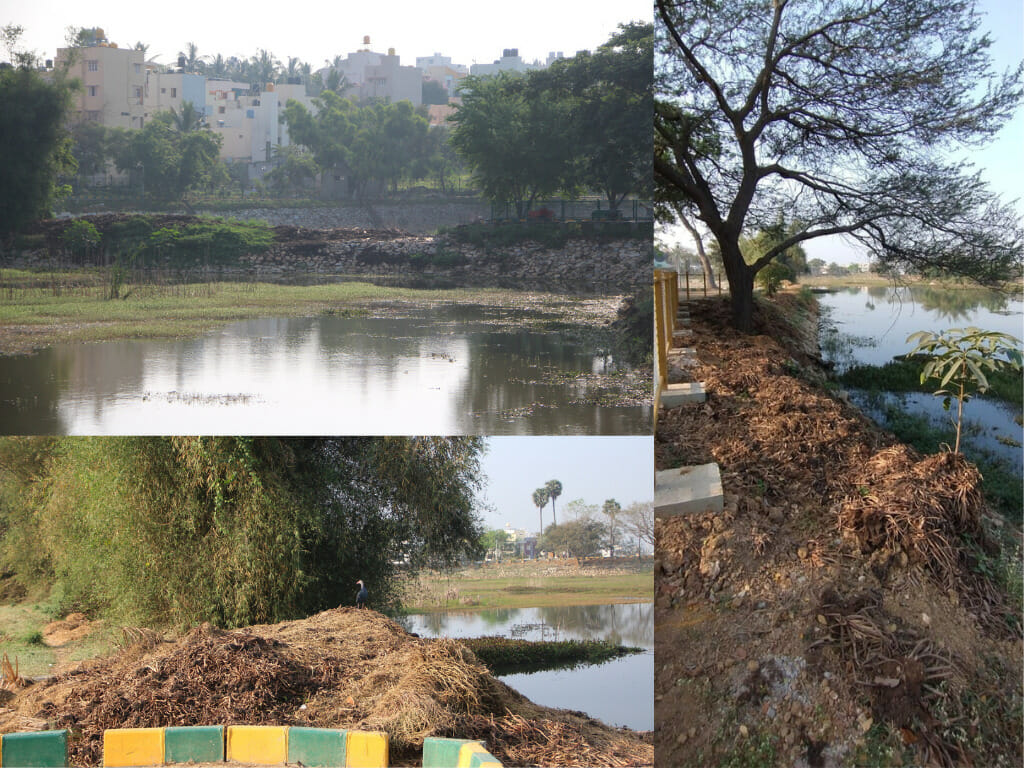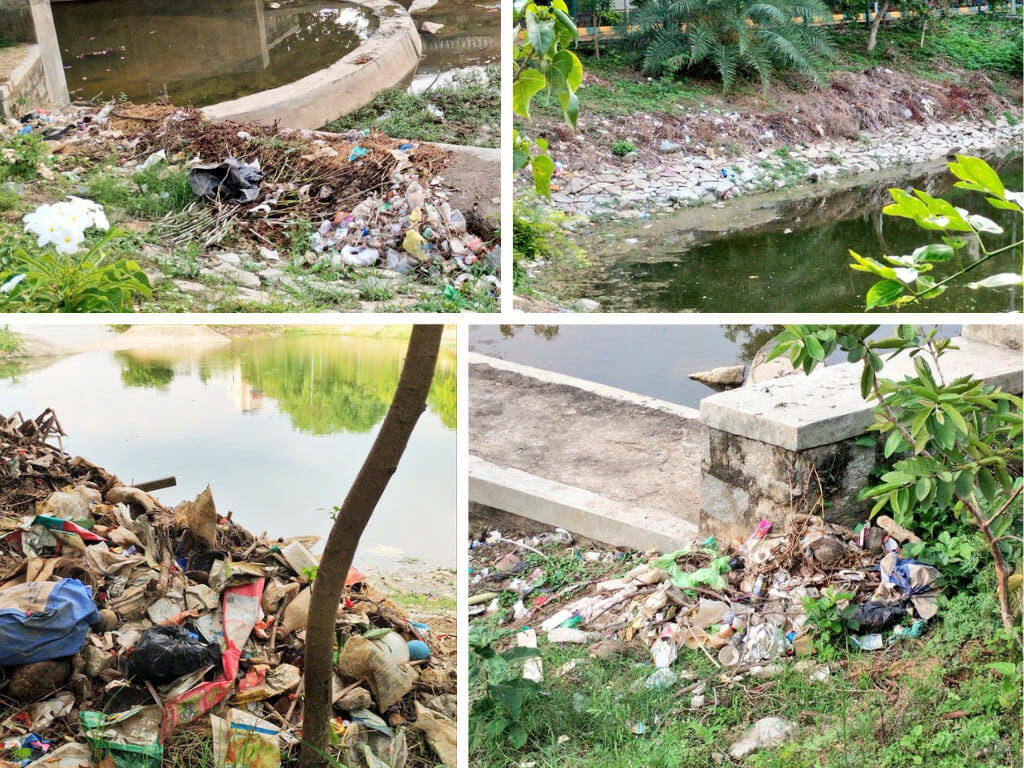Editor’s Note: The previous BJP government had announced its Bengaluru Mission 2022, under which 25 lakes were identified and funds were granted by the BBMP and CM’s Nava Nagarothana scheme in December 2020.
Three years after the announcement, with an eye on the Karnataka Elections 2023 on January 25th, the BJP government claimed in an advertisement that “47 lakes had been developed under the Nava Nagarothana scheme at the cost of 317.25 crores.”
The reality, however, is in contrast to the claims, as a citizen found out. The author, a birdwatcher, a naturalist, and a passionate conservationist did the rounds of six lakes and documented his findings of the status on the ground.
In the first part of the series, the author examines the status of four lakes. These are Doddakallasandra, Kothnur, Yelachenahalli and Chunchaghatta lakes. All the lakes are part of the so-called rejuvenated lakes.
Doddakallasandra Lake
Doddakallasandra Lake is biodiversity rich. A biodiversity report by ActionAid Association, with support from NTT Data Services, was prepared in 2020, during which 71 birds were observed over a period of 12 months, covering different trees, plants, birds and plants, butterflies. We now find that the lake is visited by 111 species of birds.
Now, we (lake volunteers) have been very conscious about the lake’s water quality. We have ensured, in over one year, that the water quality is under Class D, suitable for wildlife and fisheries. There is a constant check on entry of pollutants. Different local community members also contribute to keeping an eye.
Whenever there is an entry of a pollutant, they alert us so that we raise it with the concerned officials and ensure that it is sorted out within at least a week’s time.
Our observations:
- We have noticed that all the harvested macrophytes/aquatic plants and grass from the lake waters are placed on the bund and left for as long as three to four months. This adds to the risk of this grass getting back to the lake waters and affecting the water body.
- Apart from this, we are also not happy with the way solid waste management is done. The maintenance people collect all the waste accumulated in the wetland or in the lake and place it on the bund again. During the monsoon period, most of this solid waste goes back to the lake.
- Recently, we observed that the accumulated garbage is being burnt and that it is sometimes buried in some of the areas, where people don’t walk. So maintenance is a big challenge.
- We found two instances of underground (UGD) chamber spillover, which entered the lake through rainwater, harvested structures and polluted the lake, sometime in February this year, and again in May, during the monsoon rains.
- At present, we have seen issues with the diversion channel silt that has accumulated, due to which the water movement flow has slowed down. Sometimes, it is also backing up, as the sewage diversion channel has not been opened up for two years. It is filled with silt and has clogged in portions. This leads to it backing up into one of the inlets and joining the lake.

We have brought this to the notice of the BBMP officials, but a solution is yet to be found. Just four days ago when I visited Doddakallasandra, I could see fishes gasping for air.
I have seen this in other lakes as well. So it is likely that the water within the lake has now reached an optimum level, where dissolved oxygen is reduced drastically. We need to see the water test result to check the status.
Read more: Whom do you call to fix your lake?
Kothanur Lake
Kothanur Lake is on one of the streams contributing to the Koramangala-Challaghatta (KC) Valley. Its catchment area is around Jamboo Savari Dinne, which is one of the highest points of Bengaluru. It is situated on a lower gradient, it is nearly 30 feet lower than the main road.
We have observed two main issues:
- Solid waste: It has two inlets, one of the main inlets collects more rainwater. Unfortunately, this inlet also brings in solid waste and plastics along with it to the lake. Maintenance is one of the main challenges of this lake. The present practice in maintenance is (after many requests with the concerned officials) that they come and collect all the solid waste and keep it on the bunds.
The unhealthy practice of keeping the solid waste and plastics on the bund is dangerous for the birds that come to visit the lake and it also tends to go back into the lake.
2. Sewage: Houses are built up to the gates of the lake, one of the UGD chambers right opposite to the lake gate, which constantly overflows. The UGD line connects to the houses near the lake entrance, and a diversion channel at Kothanur lake runs under the walking path. So, the local sewage from the UGD is carried towards the lake, and connects it to the Rajakaluve next to the lake. This leads to multiple instances of overflowing sewage entering the lake. BWSSB has responded, but often quite late. There is an issue with the UGD infrastructure in that area, which has not been addressed so far.
One of the challenges is second and third smaller inlets, which bring untreated water from the village, while BWSSB claims it is not sewage water and excuses themselves while BBMP Lakes department claims it is from the village and we cannot do anything about it.
The lake has seen two instances of Fishkill this year and two instances last year too. In spite of numerous complaints to KSPCB hasn’t helped in stopping this polluted water intrusion into the lake.
So maintenance is one of the major issues with this lake, particularly during the monsoons. It needs regular upkeep. Solid waste should be disposed off from the lake, and not to be placed on the bund.

Yelachenahalli lake
Yelachenahalli lake or Anayapa tank, as referred to by the Pollution Control Board, is linked by a stormwater drain, which is a source of water. The stormwater drain is filled with silt and water.
It passes through one side of the drain as the water flows through the drain. There is a road culvert, after which it enters the lake area. There is a dive drain with a structure in it.
This has got a diversion drain and it also enters the lake. Now, that structure where the diversion drain starts, is again filled with stormwater silt and is heavily filled with polluted silt.
If it is not cleaned, all the silt from the stormwater drain and the structure area enters the lake area. Further down the lake there is a small suspension pond.
Before the suspension pond, there is a small culvert, which is inside the lake. Under this culvert the colour of the water is blackish. Further through the suspension pond, the water’s colour changes to parrot green, where algal growth has already set in and is in the last stage of blooming.
If you refer to the Pollution Control Board report for the month of April. It is already classified as category E, which is not conducive for wildlife and fisheries.
There is a history of fish kill, probably due to the entry of chemicals last year. And so there is an urgent need to clear all the silt and get ready for the monsoons before all the silt enters into the lake.
Read more: Why pre-monsoon showers lead to fish kill cases in Bengaluru’s Lakes
Chunchaghatta lake
Chunchaghatta lake is a part of the Koramangala-Challaghatta Valley (KC Valley) stream. Upstream, it is connected through Kothanur lake and downstream it is connected to Sarakki lake. It has got one major Rajakaluve inlet. Rajakaluve inlet is more or less comparatively clean as it passes through the local developed area and UGD is not a major issue at this point of time, but there are surprises sometimes, which have been caught and stopped. Recently, on May 27th, I observed a live stream of untreated water running into the #ChunchaghattaLake.
BBMP had recently developed a suspension pond for the benefit of the lake because it has now been taking all sorts of water, filtering it to some extent, and then forwarding it to the larger lake.
Chunchaghatta is special, because compared to other lakes, it has a shallow water region in some portions where water reduces, so it attracts nearly threatened species like painted stork, oriental darter, black headed ibis.
These three bird species have been regular visitors during the shallow waters. As for the issues, BBMP did not prepare the suspension pond because the lake had already accumulated so much silt in the last one and a half to two years that it was not cleaned.
It is now filled with water with all the recent rains. Unfortunately, the water will carry a lot of nutrients. But there are other inlets, particularly linked to the local village. These inlets bring in untreated water during the dry season as well, and BWSSB has not been able to fix it so far.
It also brings in a lot of solid waste, which is already spread across the lake bed. Again, maintenance is one of the major challenges. The maintenance is not up to the mark and they don’t regularly clear all the solid waste on the lake bed.
They also had this practice of keeping the solid waste on the bund most of the time. It has been entering the water again during the last few rains. A lot of plastic waste has entered the lake bed. It is already filled up on the lake bed, which is why the water level is increasing. And it is not being cleaned. So in the coming days, I think maintenance should be taken up on a regular basis.
[The second part of the series will explore the condition of three other lakes]